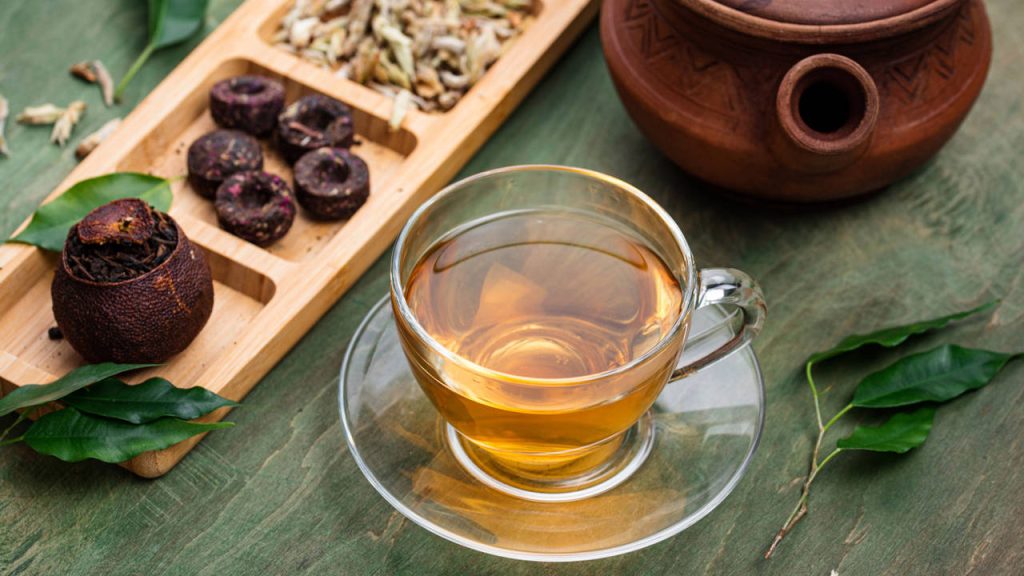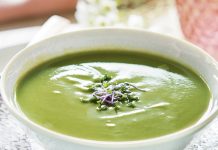Red tea or Pu-erh undergoes fermentation that gives it a unique flavor and properties. But to what extent does it have benefits for weight loss, constipation or cholesterol?

- What is red tea?
- Red tea: what is it for?
- How to prepare red tea
Red tea, also known as Pu-erh or Purer tea, is a unique type of tea due to the fermentation process through which it is made, which gives it specific properties that are different from other types of tea.
Its consumption has been associated with better digestion, constipation relief, weight loss and reduced cholesterol levels, among other benefits.
WHAT IS RED TEA?
Red tea or Pu-erh tea is native to the Chinese province of Yunnan. In fact, its name comes from a village in this area, Pu’er, which was formerly an important tea trading point. It is made with the leaves of Camellia sinensis (like all teas) that grows in this region, so it should not be confused with the infusion of rooibos, which is sometimes also called “red tea”.
The main difference from other types of tea is that Pu-erh undergoes a fermentation process. There are two varieties:
- The more expensive raw Pu-erh red tea (Chinese: sheng), which is made through a natural fermentation process that can last several years (from 5 to 60 or 70). It has a light color and a vegetable and somewhat bitter taste. Its taste and value, as with wine, is considered to improve over time.
- Mature Pu-erh red tea (shu), which is produced with an accelerated fermentation process in about 45 days. It is the one that we usually find more commonly in Spain. Its color is darker and reddish and its flavor is more earthy or woody.
You can find the leaves compressed or pressed in different shapes, such as cakes (called bing or beeng), bricks or small nests (touch), so that it can be stored and aged more easily.
RED TEA: WHAT IS IT FOR?
All teas contain antioxidants, but the fermentation process of red tea makes it especially rich in these compounds that help protect cells from free radical damage. It also contains anti-inflammatory compounds, some of which are produced in the fermentation process of tea.
Among the benefits of Pu-erh red tea are:
- Weight control: Pu-erh tea has gained fame for its possible benefits as a weight loss aid, since it increases energy levels (thanks to its caffeine content) and helps in the metabolism of fats. However, it should be borne in mind that the studies that support this effect are done in animals and there is no conclusive evidence in humans.
- Cholesterol l reduction: Fermentation of Pu-erh tea produces small amounts of a chemical called lovastatin, which (in much larger amounts) is used as a cholesterol-lowering drug. Regular consumption of Pu-erh tea has been associated with an improvement in LDL (bad) cholesterol and an increase in HDL (good) cholesterol.
- Helps digestion: its consumption has been associated with an improvement in digestion and relief of constipation, something that is believed to be due to its content in antioxidants and polyphenols, which help the breakdown of fats.
- Blood sugar regulation: Some studies indicate that Pu-erh tea might help regulate blood glucose and improve insulin sensitivity.
- It favors the immune system, thanks to its antioxidants.
- Some studies also indicate that it may help inhibit the growth of cancer cells, although they are inconclusive and more research is needed. It is also believed that drinking red tea could be beneficial for liver health.
- It should also be borne in mind that, containing caffeine and theine, excessive consumption of Pu-erh tea can lead to insomnia or sleep problems, as well as hypertension or tachycardia.
HOW TO PREPARE RED TEA
- The traditional brewing technique of Pu-erh tea (and other Chinese teas) is known as Gongfu Cha and involves several short infusions to bring out the flavor of the tea. A gaiwan is usually used, a container consisting of three parts: lid, bowl and plate; although you can also use a kettle.
Follow these steps to brew Pu-erh red tea:
- Take the amount of tea you want (as a general rule, it is usually considered that 1 to 2 grams per 100 milliliters of water is enough) and put them in a teapot or gaiwan.
- Pour hot water and empty it immediately. This serves to clean the tea leaves.
- Pour hot water back into the teapot or gaiwan (just below the boiling point) and leave it for 10 to 30 seconds.
- Pour this first infusion into the cup or a pitcher and enjoy it with small sips.
- You can repeat the infusion of these same tea leaves several times (until the flavor decreases), increasing a little the time that the hot water is with the leaves.








